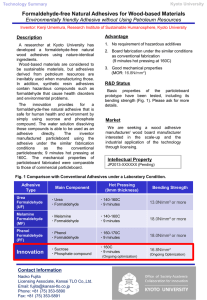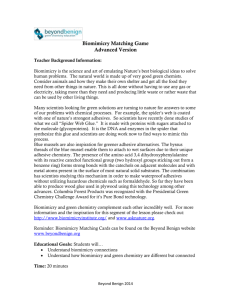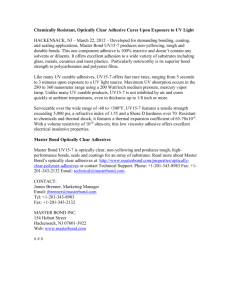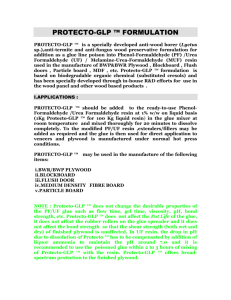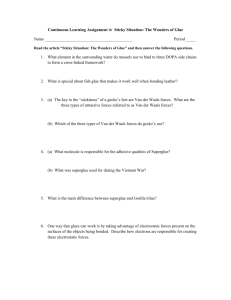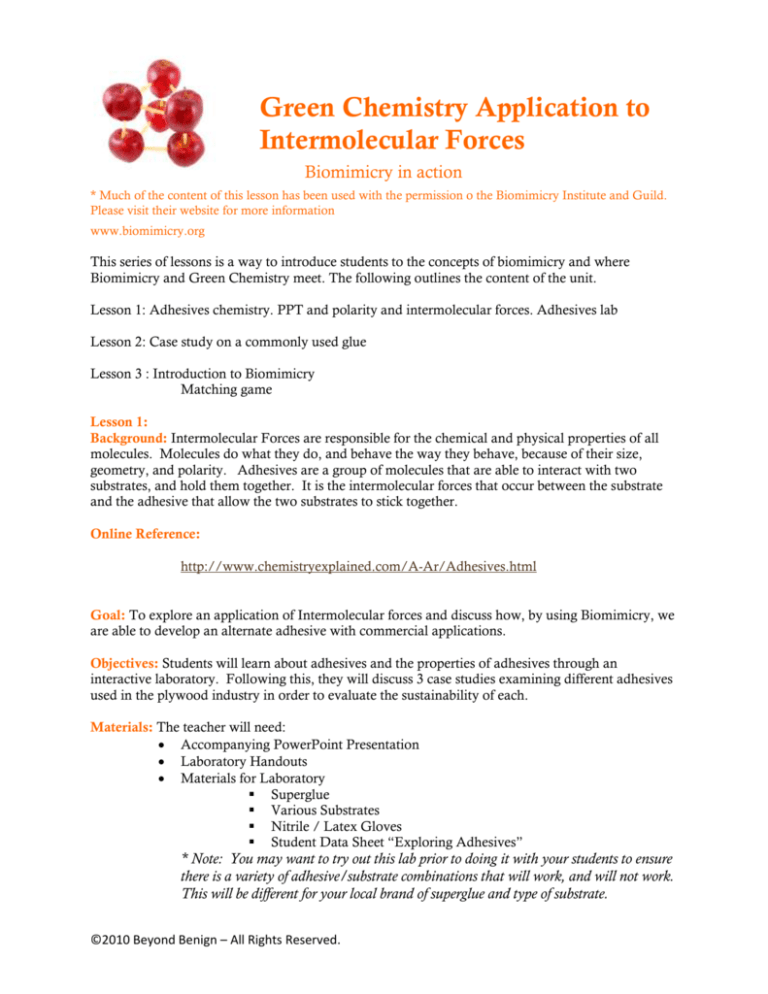
Green Chemistry Application to
Intermolecular Forces
Biomimicry in action
* Much of the content of this lesson has been used with the permission o the Biomimicry Institute and Guild.
Please visit their website for more information
www.biomimicry.org
This series of lessons is a way to introduce students to the concepts of biomimicry and where
Biomimicry and Green Chemistry meet. The following outlines the content of the unit.
Lesson 1: Adhesives chemistry. PPT and polarity and intermolecular forces. Adhesives lab
Lesson 2: Case study on a commonly used glue
Lesson 3 : Introduction to Biomimicry
Matching game
Lesson 1:
Background: Intermolecular Forces are responsible for the chemical and physical properties of all
molecules. Molecules do what they do, and behave the way they behave, because of their size,
geometry, and polarity. Adhesives are a group of molecules that are able to interact with two
substrates, and hold them together. It is the intermolecular forces that occur between the substrate
and the adhesive that allow the two substrates to stick together.
Online Reference:
http://www.chemistryexplained.com/A-Ar/Adhesives.html
Goal: To explore an application of Intermolecular forces and discuss how, by using Biomimicry, we
are able to develop an alternate adhesive with commercial applications.
Objectives: Students will learn about adhesives and the properties of adhesives through an
interactive laboratory. Following this, they will discuss 3 case studies examining different adhesives
used in the plywood industry in order to evaluate the sustainability of each.
Materials: The teacher will need:
Accompanying PowerPoint Presentation
Laboratory Handouts
Materials for Laboratory
Superglue
Various Substrates
Nitrile / Latex Gloves
Student Data Sheet “Exploring Adhesives”
* Note: You may want to try out this lab prior to doing it with your students to ensure
there is a variety of adhesive/substrate combinations that will work, and will not work.
This will be different for your local brand of superglue and type of substrate.
©2010 Beyond Benign – All Rights Reserved.
Copy of Student Case Study handouts
PowerPoint entitled “Biomimicry”
Teacher procedure:
Lesson 1:
Introduce students to adhesive chemistry using the PPT that accompanies this lesson.
Discuss different adhesives, substrates and how IMFs impact on the “wetability” of the
adhesive on the substrate.
Explain that they are going to experiment with some adhesives to understand intermolecular
force and why things stick together.
Emphasize here that adhering things to one another is a very important part of making the
products we use and that many chemists spend time formulating better adhesives.
Complete Lab “Exploring Adhesives”
At the end of the lab ask students if they think that the adhesives they used were green. Have
them think about lifecycle and sustainability. Why do they think the products may not have
been green – did they give off a bad smell. What is their background information?
Lesson 2:
Explain to the students that today they will be looking at a case study about a common use
of adhesives and how that process has evolved to be more sustainable.
Hand out Case Studies 1 & 2. Students are to read the case study, and discuss the Principles
of Green Chemistry as they relate to each case. Complete the back page of the case study
Note: For some of the 12 Principles, there may be little/no impact for the process.*
Hand out Case Study 3 and discuss the Principles of Green Chemistry as they relate to the
case.
Following analysis of all 3 Cases, discuss how the use of Adhesives in the Plywood Industry
have progressed.
Lesson 3
Introduce students to the concept of Biomimicry using the PowerPoint “Biomimicry”. If you
have internet access you may also want to have them take a look at the Biomimicry website
at www.biomimicry.org
Hand out Biomimicry Matching Game worksheet, asking students to examine different
commercial adhesives, and match them to different Biological Adhesives, matching the two
up.
©2010 Beyond Benign – All Rights Reserved.
Exploring Adhesives
Student Sheet
Background: The ability of an adhesive to bond two substrates together is dependent on the strength
of the intermolecular forces and interactions between the glue and the substrate molecules. The
adhesives “wetting” ability refers to the ability to form stronger interactions with the substrate than it
does with itself.
Materials: Each student group will need:
Super glue
Various substrates:
o Wood (scraps from wood shop or home improvement store)
o Polypropylene (lids from carbonated beverage bottle)
o PET – (carbonated beverage bottle)
o Glass - (Glass beverage bottles)
o Ceramic (broken Coffee cup)
o Rubber (old tire inner tube)
o Metal (small aluminum pie pans)
o Other
Safety glasses
Popsicle Stick
Paper towel
One pair Latex or Nitrile gloves per group
Procedure:
1. Obtain all materials from lab area and return to work station
2. Ensure safety glasses are worn by all members of the group, and that the member
applying the glue is wearing gloves
3. Apply a layer of superglue to one surface of the first substrate, by squeezing the glue
from the tube, and spreading with the Popsicle stick using the long flat edge. Make
observations on data table
4. Press the second similar substrate against the adhesive to sandwich the adhesive
between the two similar substrates. Note the time on the data sheet.
5. Repeat steps 3 and 4 with the remaining substrates. Be careful to apply similar
quantities and spread evenly for each trial.
6. Once adhesive has set for 10 minutes, you may begin to attempt to separate the
substrates. Comment on the relative ease in which you were able to do so, if they
were able to be separated.
7. Cleanup work station. Alert teacher to any superglue spills that may be cleaned up
using acetone.
Data: Complete the following chart:
Brand name of Superglue:____________________
Active Adhesive component:_________________
©2010 Beyond Benign – All Rights Reserved.
Substrate
Type
Observations from
spreading layer of glue
Time of
Adhesion
start
Time of
Adhesion
finish
Total
Adhesion
time
Observations on ease of
separation
10 min
10 min
10 min
10 min
10 min
Conclusion: From the observations, it can be concluded that ____________________________
_____________________________________________________________________________________
_____________________________________________________________________________________
_____________________________________________________________________________________
_________________________________________________________
Analysis:
1. Which substrates were very successfully bonded together?
2. Which substrates did not bond together well?
©2010 Beyond Benign – All Rights Reserved.
3. Research the structure of the adhesive’s active component and each substrate and
comment on the polarity of each.
4. Why does acetone work to clean up any dried on superglue? Explain fully.
5. From the research, were the conclusions made earlier explained by the polarity of the
components? Explain.
6. Do you think the adhesive you worked with would be considered green against the
principles of green chemistry? Why or why not?
©2010 Beyond Benign – All Rights Reserved.
Plywood Case Study
Student Sheet
What is Plywood?
Plywood is a manufactured wood, made by gluing together a number of thin sheets or plies of
softwood or hardwood. It is a strong durable substance that is used in construction and to make
household items such as kitchen cabinets, furniture, walls of houses and garden sheds. A common
reason for using plywood instead of plain wood is its resistance to cracking, shrinkage,
twisting/warping, and its general high degree of strength. Also, plywood can be manufactured in
sheets far wider than the trees from which it was made. It has replaced lumber in construction
applications for these reasons.
Plywood is basically very thin sheets of wood glued together. The thin layers of wood are peeled
from trees. These layers of wood are called veneer. The veneer is then glued together to make
plywood. The grain of one layer of plywood only runs in one direction, so it is very hard to bend it
the opposite way of the grain line. Multiple layering of this effect makes the substance very strong.
Original method for manufacturing plywood
Background:
The history of plywood goes back to ancient Egyptian times, around 3500 B.C. where wooden
articles were made from sawn veneers glued together crosswise. The original use was intended to
replace the look of fine woods when they were not available. Thin sheets of high-quality wood were
glued over a substrate of lower quality and the result looked good, but the resulting product also had
structural benefits.
How is the plywood made?
The first plywood in the U.S. was put together by workers at the Portland Manufacturing Company
in Oregon in preparation for the 1905 World’s Fair. Portland Manufacturing Company was asked to
prepare an exhibit featuring something “new and unusual” and what they decided upon was
“plywood”.
The plywood made at the Portland Manufacturing Company was made with animal glue. The
workers mixed animal glue and kept the very odoriferous material warm and pliable over a coal fire
(the glue smelled so bad that the men would often have to leave for air outside). Hand brushes were
used to “paint” the glue on to the veneers. A wooden press was used. The work was slow and
tedious; only one set of panels could be glued up at one time and the panels were set in a press
overnight
How was the animal glue made?
Animal tissue, bones and hides are conditioned in lime (calcium hydroxide) solution. The pH is
adjusted by adding dilute mineral acid and the tissue, bones and hide are rinsed with water. The
tissue, bones and hide are then added to water and is “cooked” (heated) and the proteins (which
make up the glue) are extracted and filtered out of the solution. The protein is collected, dried and
©2010 Beyond Benign – All Rights Reserved.
ground up as final product. When heated to 140°F this substance then becomes liquefied for
application.
The glue is applied to cut and dried wood veneers by warming to about 145˚F degrees and it is set by
slowly cooling to room temperature, followed by evaporation during the following 12 to 24 hours.
What are the drawbacks of this process?
What are the positive aspects of this process?
Analyze this process according to the twelve principles of Green Chemistry:
1. Prevention.
2. Atom Economy.
3. Less Hazardous Chemical Synthesis.
4. Designing Safer Chemicals.
5. Safer Solvents and Auxiliaries.
6. Design for Energy Efficiency.
7. Use of Renewable Feedstocks.
8. Reduce Derivatives.
9. Catalysis.
10. Design for Degradation.
11. Real-time Analysis for Pollution Prevention.
12. Inherently Safer Chemistry for Accident Prevention.
©2010 Beyond Benign – All Rights Reserved.
Along comes petroleum: UF/PF Plywood
Background:
Improvements to the production speed and performance of plywood occurred with the discovery
and ready availability of oil and petroleum products. In the early part of the 20th century, petroleum
became plentiful and it became evident that its properties would revolutionize the world in terms of
making technologies possible on a large scale. The new synthetic resin adhesive which became
available was able to “cure” in shorter time frames than the traditional animal glues. The use of the
new resins, along with the invention of automated machinery revolutionized the way plywood was
made making it cheaper and less time intensive. This is the way that most plywood is still
manufactured.
How is the plywood made?
The actual production includes “peeling” a log into the appropriate dimensions, followed by the
drying of the wood, patching of any imperfections and then the gluing of the wood together. An
automatic spreader is used to spread the resin for gluing. The wood is baked in a press at
temperature and pressure conditions of, 140C (280F) and 19 MPa (2800 psi). The wood layers
(plies) are bonded together under high heat and pressure with an adhesive such as ureaformaldehyde (UF) (used for indoor purposes) or phenol-formaldehyde (PF) (used for outdoor
purposes – more water resistant). The high heat and pressure allow for the two components of the
adhesive to stick together and stick to the wood itself to produce nicely layered plywood.
What is Formaldehyde?
Formaldehyde is a naturally occurring substance in the environment made of carbon, hydrogen and
oxygen. Formaldehyde is produced industrially by the catalytic oxidation of methanol.
Formaldehyde can be toxic, allergenic, and carcinogenic. At concentrations above 0.1 ppm in air
formaldehyde can irritate the eyes and mucous membranes, resulting in watery eyes. Formaldehyde
inhaled at this concentration may cause headaches, a burning sensation in the throat, and difficulty
breathing, as well as triggering or aggravating asthma symptoms. Formaldehyde is classified as a
probable human carcinogen by the U.S. Environmental Protection Agency. The International
Agency for Research on Cancer (IARC) has determined that there is "sufficient evidence" that
occupational exposure to formaldehyde causes nasopharyngeal cancer in humans.
The primary exposure concern is for the workers in the industries producing or using formaldehyde.
The EPA recommends the use of “exterior-grade” pressed-wood products to limit formaldehyde
exposure since pressed-wood products containing formaldehyde resins are often a significant source
of formaldehyde in homes.
Phenol can be highly irritating to the skin, eyes and mucous membranes in humans via inhalation
and dermal exposure. Phenol is very toxic to humans via oral exposure (1 g reported to be lethal).
Long-term (chronic) exposure symptoms can include effects on skin, liver, kidney, respiratory,
cardiovascular and central nervous system.
How are the UF/PF resins made?
Preparation of UF and PF resins (glues) are made in similar manners. Urea (or phenol) is combined
with excess formaldehyde in alkaline (basic) conditions. This forms short chains of the ingredients.
©2010 Beyond Benign – All Rights Reserved.
The conditions are then acidified and further heating creates long chains which essentially “glue” the
wood together.
What are the drawbacks of this process?
What are the positive aspects of this process?
Analyze this process according to the twelve principles of Green Chemistry:
1. Prevention.
2. Atom Economy.
3. Less Hazardous Chemical Synthesis.
4. Designing Safer Chemicals.
5. Safer Solvents and Auxiliaries.
6. Design for Energy Efficiency.
7. Use of Renewable Feedstocks.
8. Reduce Derivatives.
9. Catalysis.
10. Design for Degradation.
11. Real-time Analysis for Pollution Prevention.
12. Inherently Safer Chemistry for Accident Prevention.
©2010 Beyond Benign – All Rights Reserved.
Biomimicry inspired, Soy-based Plywood
Background:
Inspired by the superior properties of the protein that mussels use to adhere to rocks, researchers at
Oregon State University, along with industrial partners developed wood adhesive based on soy
flour. The amino acids in soy protein were modified to give adhesive properties similar to that of the
mussel’s adhesive protein.
How is the plywood made?
The plywood is made using a similar process as what is typically used. The main difference is the
resin (glue) used in pressing and securing the layers together.
How are the soy-based resins made?
The soy-based resins are made by extracting proteins from soy flour through a water-based
extraction process. The protein is then modified slightly with either dopamine or maleic anhydride
in water-based conditions. The modified protein is mixed into a water: protein mix for preparation
for spreading and gluing of the plywood layers.
Supporting information:
Columbia Forest Products (CFP) has replaced 47 million pounds of UF resins since 2006 and has
reduced emissions of hazardous air pollutants from each CFP plant by 50 to 90 percent. The proteinbased plywood is now sold under the label PureBond by Columbia Forest Products.
Biomimicry: Nature-inspired design
As the Pacific Ocean swirled around him, a question rushed into Dr. Kaichang Li's
head : how do mussels keep their grip on rocks that are constantly pounded by waves?
Dr. Li, a professor at Oregon State University's College of Forestry, found that mussels
secrete proteins known as byssal threads, which provide superior strength and
extraordinary flexibility. His curiosity led to groundbreaking research – funded by
Columbia Forest Products and others – based in the principles of biomimicry, which
studies nature and then imitates its designs and processes to solve human problems. Li
discovered that soy proteins can be modified to perform similarly to byssal threads.
And not only did they deliver phenomenal adhesion, they also offered exceptional
water resistance. This breakthrough led to PureBond®, proving that enhanced
environmental quality and increased product performance can go hand in hand.
More info here http://www.asknature.org/strategy/1052eed7fd56c4933871c04b65b1cafb
What are the drawbacks of this process?
What are the positive aspects of this process?
©2010 Beyond Benign – All Rights Reserved.
Analyze this process according to the twelve principles of Green Chemistry:
1. Prevention.
2. Atom Economy.
3. Less Hazardous Chemical Synthesis.
4. Designing Safer Chemicals.
5. Safer Solvents and Auxiliaries.
6. Design for Energy Efficiency.
7. Use of Renewable Feedstocks.
8. Reduce Derivatives.
9. Catalysis.
10. Design for Degradation.
11. Real-time Analysis for Pollution Prevention.
12. Inherently Safer Chemistry for Accident Prevention
©2010 Beyond Benign – All Rights Reserved.
©2010 Beyond Benign – All Rights Reserved.
Biomimicry Matching Activity – Teacher Answer Key
* not all answers are exact – students should be given credit for their explanations!
Match the bio-inspiration to the current adhesive:
Common glue used
Properties
Biomimetic
possibility
Gorilla Glue
Epoxy
Elmer’s Glue
Rubber Cement
Superglue
Barnacles
Liquid nails
Silicone Adhesives
Body Lice
©2010 Beyond Benign – All Rights Reserved.
Marine Worm Sand Tubes
Land snail mucus
Setae of leaf Beetles
Glue from the velvet worm
Australian Mistletoe berries
Explanation
Biomimicry Matching Activity
Using the handout match the bio-inspiration to the current adhesive:
Common glue used
Properties
Gorilla Glue
- expands as it cures, filling gaps
- waterproof
-takes a few hours to dry so you
can reposition things if you need
to
- comes in two parts, a resin and
a catalyst
-Once cured it can be drilled,
sanded or painted
-Is sold in different drying times
- non-toxic
- can be cleaned up with water
- good for wood and paper
gluing
- easy damage free removal
- Favored in arts and crafts
projects
- will not shrink or swell paper
fibers
-Fast Drying
-creates an almost invisible bond
- Can stick human skin together
- dries out easily if not stored
properly
Epoxy
Elmer’s Glue
Rubber Cement
Superglue
©2010 Beyond Benign – All Rights Reserved.
Biomimetic
possibility
Explanation
Liquid nails
Silicone Adhesives
-Withstands temperatures from 60° to 300°F
-Acid free / Low odor
-Flexible & shock absorbing
-Works on wet surfaces
-Indoor & outdoor
-Can fill gaps up to 1/4" (6mm)
-does not adhere to polyethylene
or polypropylene
- reacts with moisture in the air
- used around water as in gasket
sealants and caulking
-Used in electronics
Make a match
The Velvet Worm: They shoot at prey with an adhesive liquid ejected by two nozzles next
to the mouth. The nozzles move from side to side as they fire, causing the stream of glue to crisscross in
a lasso-like motion. The glue travels nearly 3 feet (1 m) and dries in seconds, ensnaring the prey in
multiple strands. Fast drying glue for housing, medical emergency or everyday use.
The velvet Worm: http://www.youtube.com/watch?v=FbVDYSiH-Vw
Barnacles have the capability for tenacious underwater adhesion to the surfaces by a
proteinaceous cement substance. Three major proteins had been identified in a previous
study and this study adds a fourth. It is suggested that each cement protein fulfills a distinct
and specific role in underwater adhesion, and that firm barnacle adhesion is achieved
©2010 Beyond Benign – All Rights Reserved.
cooperatively by these cement proteins. Understanding the specific role of each cement protein will help to provide a better understanding
of barnacle settlement and of synthetic polymer mimics, including underwater adhesives
Setae of Leaf Beetles: The thousands of setae (pads on the bottom of the feet) of
leaf beetles enhance their ability to adhere to various, sometimes irregular surfaces thanks to the
resulting multiple contact points. These feet are designed to temporarily stick but also peel off at
will without damaging the surface underneath. There is also no wetting process so there is no
residue or liquid involved. Setae of leaf beetles:
http://www.youtube.com/watch?v=HTbrsx1zARs&feature=related (video about setae of
a gecko but has the same science as the leaf beetle) http://www.youtube.com/watch?v=ECpY2N5rgcM
Australian Mistletoe Berries: One particular bird, the mistletoe bird, eats
little other than mistletoe berries. There are so many species, each with its own fruiting
season that the bird is able to find berries throughout the year and it flies along regular
migration routes in order to do so. Its digestive system is specially modified to cope with this
diet. For some reason, it processes the berries with remarkable speed so that one will take less
than half an hour to travel from entry to exit. When it emerges the seed still has considerable
residual stickiness and so remains fastened to the bird's rear. The defecating bird does not,
however, sit transversely across a twig waiting for the mistletoe seed to drop off. Instead, it turns so that its body is aligned along the twig
and carefully wipes its bottom on the bark beneath. This fixes the seed to the tree but threads of the seed's glue still remain attached to the
bird's rear and it has to make three separate sideways jumps along the twig before the connection is finally broken." Scientists belie it could
be used in adhesives for sealing pipes or cables, adhesives for use in pre-fabricated building products or furniture, bonding applications for
electronics
Land Snail Mucus: The trails of land snails are non-toxic and water soluble. There are specific proteins
in the adhesive mucus in the slug Arion subfuscus and the land snail Helix aspersa. Such a mechanism may be common
among invertebrates, and it may guide biomimetic approaches in the development of glues and gels. Glues and gels
without harsh chemicals
©2010 Beyond Benign – All Rights Reserved.
Marine Worm Sand Tubes: The colonies built by Sabellaria worms on seashore rocks look like very untidy honeycombs.
The worms construct tubes of sand grains stuck together with mucus. Sabellaria worms are marine worms about 30 mm long which build
tubes by cementing together particles of sand and rock. The cement they create is extremely strong and it is imagined that there might be an
application in the construction industry. Could be used in Biolubricants and construction glue. Sabellaria worms:
http://www.youtube.com/watch?v=5Bt9Tsc9Y-g
Body Lice: Eggs of body lice, commonly called 'nits', are attached to the body hairs of the host by a cementlike substance. They form a cement-like structure that resists moisture and high temperatures.
©2010 Beyond Benign – All Rights Reserved.

